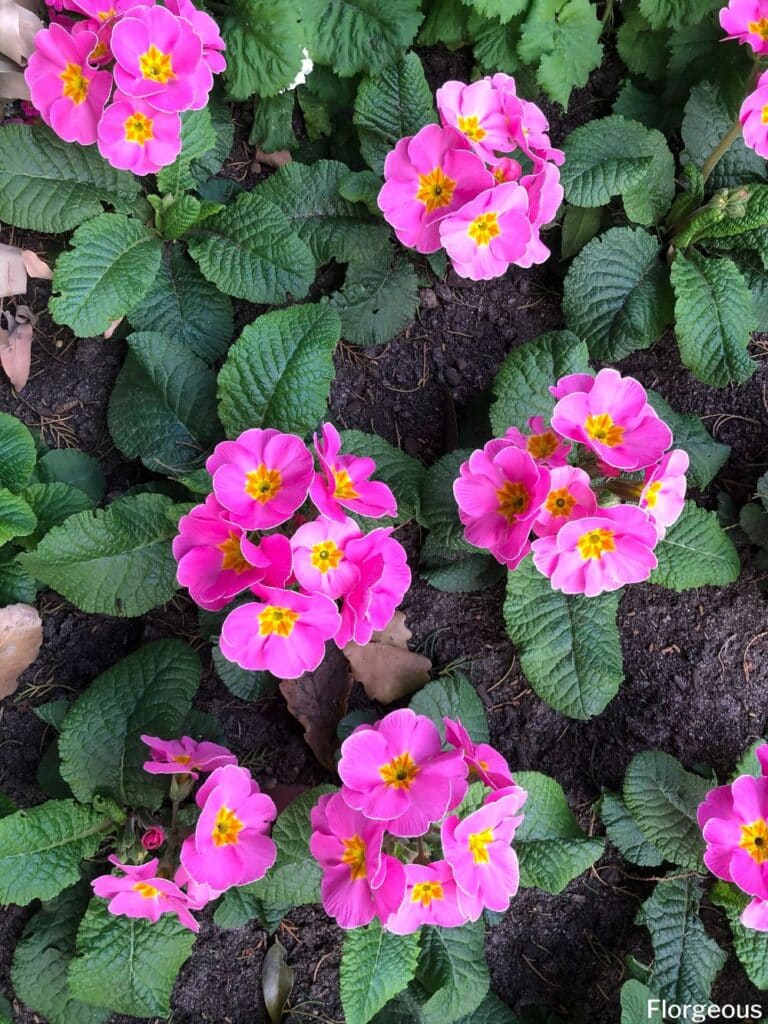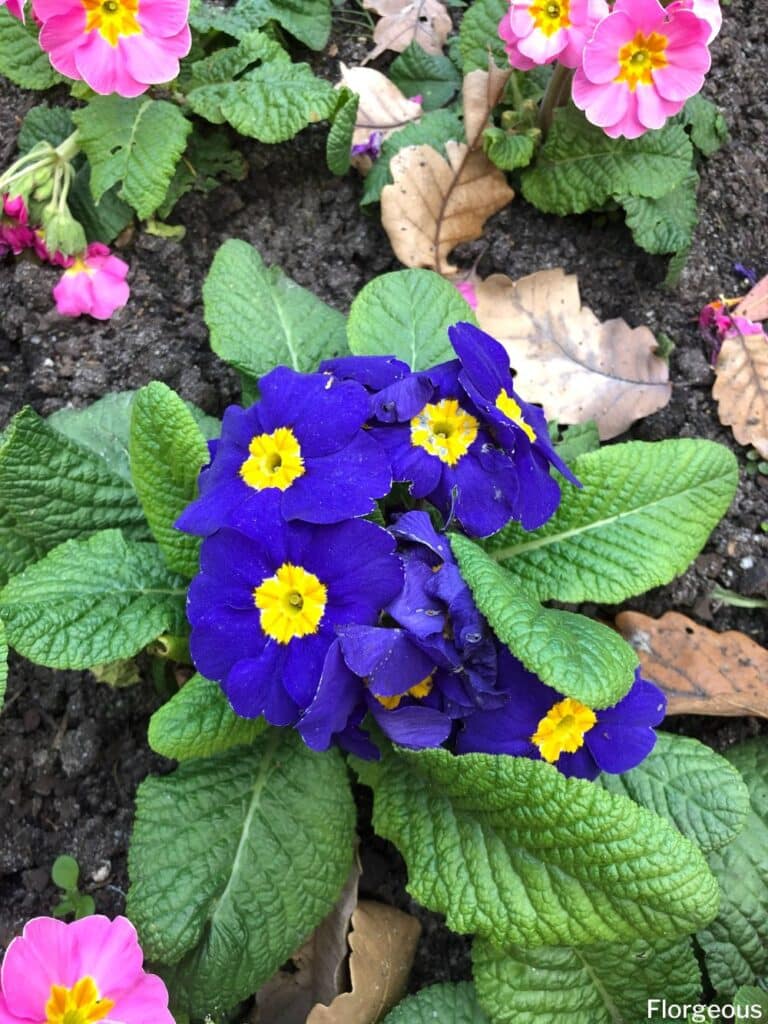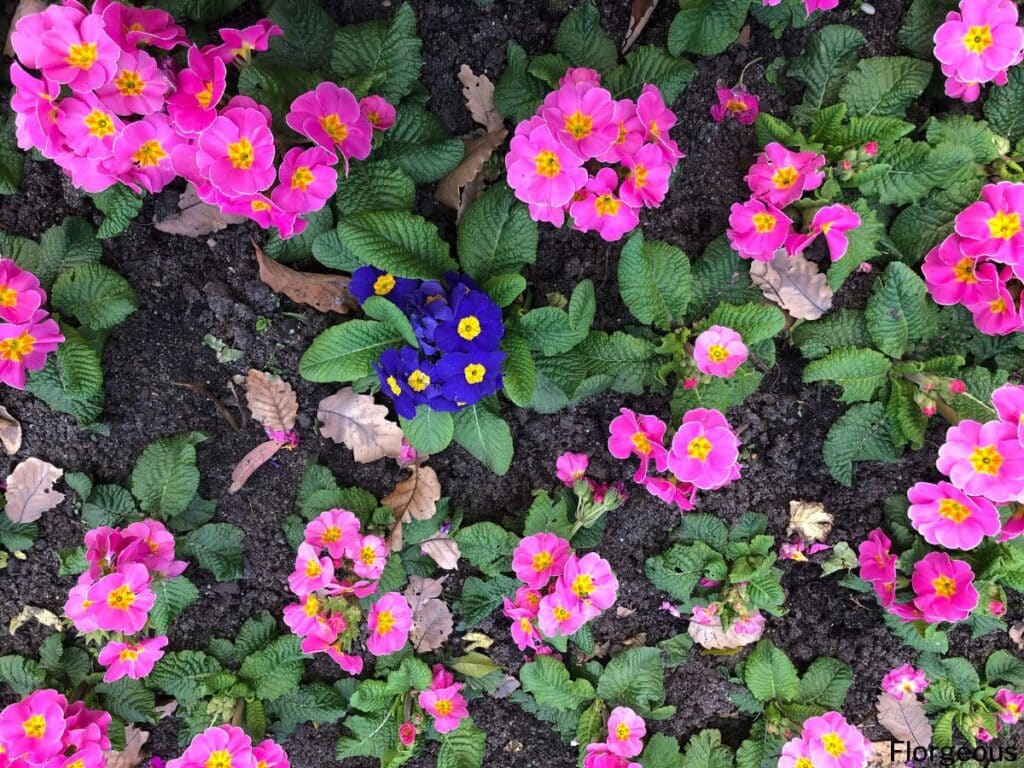Primroses (Primula vulgaris) are ornamental plants that add a pop of color anywhere you place them. They’re one of the most popular flowers for garden use, and their diverse types and countless hybrids can attest to that.
It grows 1 to 2 feet tall and blooms in late spring and early summer with white, pink, red or purple flowers.
In this guide, we’ll go through the basics of primrose flowers, including facts, different varieties, growing tips, and more.
Ready to learn everything you need to know about primrose care?
Plant Facts
| Scientific name | Primula vulgaris |
| Common names | Primrose Flower, Common Primrose |
| Family | Primrose/Primulaceae |
| Plant Type | Houseplant, Garden Plant |
| Height and Width | 8-12 inches tall, 6-18 inches tall |
| Origin | Western and southern Europe, southwest Asia, northwest Africa |
| Flower colors | Yellow, white, pink round flowers |
| Foliage color | Dark green |
| Sun Exposure | Bright, indirect sunlight (partial shade in warm environments) |
| Soil Type & pH | Well-drained soil |
| Special features | Adds color during winter months, good for cold frame, great for backyard garden planting or as a ground cover, can be grown in containers |

How to Grow Primrose
Primrose flowers have a long blooming period and can be grown as potted primrose or outdoors, in your garden bed. As long as you keep the soil moist and ensure a bit of morning sun (or filtered sunlight, if growing indoors), you shouldn’t have any trouble growing primrose in any setting.
Let’s take a look at what you’ll need to know for growing primroses. Here are some tips that you can follow regardless of whether you want to see primroses bloom outside in your garden or inside, in potted indoor plants.
Propagation
It’s relatively easy to grow primroses as these plants are quite hardy and highly adaptable to various conditions. You can start growing one through propagation, but there are ready-to-plant primrose materials available at most garden centers and nurseries.
These herbaceous perennials can be grown from seeds, divisions, or cuttings. When planting primroses, space the plants about 4 to 12 inches apart as these plants like to spread (2). Larger varieties require bigger plant spacing.
- Planting by seeds: Sow primrose seeds in a planting mix with equal portions of soil, peat moss, and sand. Keep the planting mix moist to allow the primrose seeds to germinate. Then, wait for the seedlings to grow their second and third leaves before transplanting them into the ground or pots.
- Planting by division: Divide healthy primrose plants after flowering. Do this by carefully digging up a selected plant, then cutting the big clump into smaller divisions. Use a clean and sharp knife as you do the process. Replant the divisions and water thoroughly after.
- Planting by cuttings: Some primrose varieties can be reproduced using leaf cuttings. After blooming, select a healthy leaf with about 1.5 inches of stem. Then, plant primroses into a potting mix with vermiculite, perlite, and sphagnum moss. The cutting will be ready for transplanting when new root growth has formed.
Soil
Primroses grow best in fertile and well-draining soil. The ideal soil pH should be slightly acidic to slightly alkaline (2). You can also amend the soil with organic matter to improve its quality and condition.
Avoid overly wet soil when growing these flowers, regardless of whether you’re growing primroses as indoor plants or in your garden beds. These pale yellow flowers require well drained soil to avoid rot.
Pruning
Regular pruning helps primroses maintain their attractive facade and healthy state. Cut off dead leaves and spent blooms regularly after your plant has finished blooming.
Repotting and Transplanting
Repotting and transplanting primrose requires extra care due to the delicate nature of the plant. Water generously and wait until it is properly hydrated before attempting to move it.
If possible, wait until the primrose plant has finished flowering at the end of the growing season to do this. Try to support the entire root system as you take the primrose flower out of its old pot, because this will reduce the stress on your plant.
Plant your primroses in well-drained soil that can retain moisture well. If any roots are damaged or dying, be sure to trim them away so that the plant can focus its energy on new and healthy growth. Make sure not to overcrowd the roots in the new pot; you want enough room for them to spread out once the plants are mature.
After transplanting has been completed, keep an eye on your primrose for a few weeks and ensure that it has adequate water and sun exposure.

How to Care for Primrose Plants
Here are some tips for caring for potted primrose as well as primrose growing directly in the ground.
Water
Watering primroses shouldn’t be tricky. They enjoy moist soil like most plants, especially since they can be susceptible to drought. Deep watering your primrose plants regularly, ideally once a week, will make them vigorous.
However, avoid overwatering since excessive moisture in the soil often leads to root rot, which is not good for them (2). Water the plants before the top surface of the soil dries out completely.
Sunlight
Most Primula species thrive best in partial shade, but a few do just as well in full sun. Outdoors, most primroses prefer lightly shaded areas, with dappled and indirect sunlight. Avoid too much direct sunlight since it may cause leaf burn.
However, in the case of indoor primrose plants, bright light is ideal for thriving. Place potted primrose plants in a well-lit area indoors with a good amount of sunlight throughout the day. This is important since insufficient light may affect the plant’s flowering ability. They can tolerate a bit of light shade but will go dormant with too much shade, especially if there is too much moisture, as you might find in the mid to late winter.
When selecting primrose companion plants, you need to make sure they have the same sunlight requirements as primrose.
Temperature and Humidity
Growing primrose flowers indoors requires a range of about 50 °F at night to 70 °F during day time (2). You can grow potted primroses indoors, provided that the night temperatures fall between 50 and 60 °F (typically in the early fall). Generally, these plants do not tolerate extreme temperatures, particularly during the growing period.
Bring your potted primrose plants inside before the first frost of the season to preserve your flowers from the cold.
Primrose flowering plants need just the right amount of humidity to stay vibrant and healthy. Generally, a humidity rate of 60-70 percent is the ideal atmosphere for these beautiful flowering plants. To ensure your potted primrose stays humid enough, it’s important to check the soil moisture each day.
Adjust watering as needed and remember never to let the soil dry out completely. Adding a humidity tray surrounding the pot can also help maintain adequate humidity levels for your plant.
Fertilizer
Primroses grown indoors do not necessarily need fertilization (2). Still, like other garden plants, these blooms appreciate light applications of fertilizers during their growing period.
Apply a balanced, water-soluble fertilizer at half of the recommended rate every two to four weeks. Stop feeding the plants after primroses blooming. These delicate flowers don’t respond well to fertilizer once they’ve emerged.
Pest and diseases
Although primroses are not easily affected by known pests and diseases, they can still be highly susceptible to minor damages caused by several insects or poor growing conditions.
When grown in poor drainage, primroses can be prone to rot diseases like root rot and crown rot. Poor drainage, soggy soil, and excessive soil moisture are highly favorable for plant diseases and other fungal infections. Although these can be fatal to affected plants, they can easily be fixed by amending the soil with compost, ensuring proper watering practices (good watering habits are key!), or transferring them to a well-drained area.
Slugs and snails are common pests that affect primroses, but they can easily be controlled using non-toxic methods like non toxic slug bait products. Other insect pests of primrose plants include spider mites, vine weevils, and aphids. These primrose plant pests can usually be treated by natural methods like horticultural oils and diatomaceous earth.
Common Varieties and Cultivars of Primrose species
There are countless types of primrose plants within the Primula genus that you might consider growing in your backyard garden. Some of the most popular varieties, cultivars, and subspecies to grow in the early spring season include:
- Drumstick primrose
- Candelabra primroses
- Japanese Primrose (Primula japonica)
- Primula veris (Cowslip primrose)
- Primula denticulata
- Primula polyantha
- Primula capitata
Conclusion
There you have it! Everything you need to know in order to care for primroses, regardless of whether you are growing these colorful flowers when they are planted outdoors or if you prefer to care for them as house plants.
Enjoy their pink flowers and dark green leaves from early spring until fall – you won’t regret it!
FAQs
Do primroses need direct sunlight?
Yes, Primroses (Primula) prefer partial to full shade and can thrive in indirect sunlight. While they can tolerate some morning sun, providing them with shade during the hottest part of the day is beneficial.
What to do with primroses when they finish flowering?
When primroses finish flowering, remove spent blooms to encourage the production of new flowers. If the entire plant has finished blooming, you can trim it back to promote overall health and potentially trigger a second round of blooms.
How long do primrose flowers last?
The duration of primrose flowers depends on the specific species or cultivar. Generally, primrose flowers can last several weeks, and some varieties may continue blooming for an extended period under suitable conditions.
Where do primroses grow best?
Primroses grow best in cool, moist environments with well-draining and rich soil. They are well-suited for woodland gardens, shaded borders, or areas with partial shade. Ensuring consistent moisture and providing protection from hot afternoon sun contributes to their optimal growth.
Final thoughts
With their cheerful blooms and easygoing nature, primrose flowers make the perfect addition to any garden. Whether you choose cheerful yellows, vibrant pinks, or sweet violets, remember that a little primrose flower care goes a long way.
Keep them in dappled sunlight, water gently, and give them some well-draining soil, and you’ll be rewarded with a symphony of color that brightens your days for seasons to come. So get planting, and say hello to the sunshine spirit of these charming early bloomers!
See more: Primrose Flower Meaning and Symbolism
References
Reference List:
(1) Plants Profile for Primula (primrose) (2020). Available at: https://plants.usda.gov/core/profile?symbol=PRIMU
(2) Pick a Primrose For a Pop of Perfection (2020). Available at: https://extension.psu.edu/pick-a-primrose-for-a-pop-of-perfection
(3) Primula vulgaris (Primrose) | North Carolina Extension Gardener Plant Toolbox (2020). Available at: https://plants.ces.ncsu.edu/plants/primula-vulgaris/
Close
Image by depositphotos.com/[email protected]







